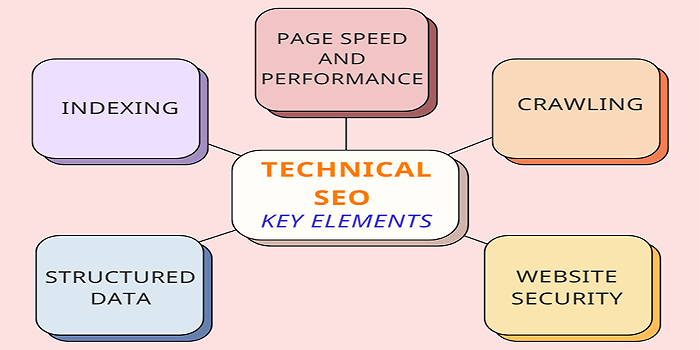In the digital realm, where search engine algorithms constantly evolve. Mastering the art of Technical SEO is paramount for achieving and sustaining higher rankings. This guide aims to demystify Technical SEO for beginners, providing insights into its core components. Importance, common issues, best practices, and the path to optimizing your website for enhanced visibility and success.
Table of contents
Technical SEO
Technical SEO encompasses the optimization of your website’s infrastructure and backend. Elements to improve its search engine visibility and user experience. While traditional SEO focuses on content and keywords, Technical SEO dives deeper into the technical aspects. That influence how search engines crawl, index, and rank your site.

- Website Speed Optimization: Ensuring fast loading times by optimizing images, using efficient codae, and leveraging caching techniques.
- Mobile-Friendly Design: Creating a responsive design that works well on mobile devices. Improving user experience and meeting search engine mobile-friendliness criteria.
- Structured Data Markup: Implementing schema markup to provide search engines with structured data about your content. Enhancing visibility in search results with rich snippets.
- XML Sitemap and Robots.txt: Creating and maintaining an XML sitemap to help search engines understand the structure of your site. And using a robots.txt file to control crawler access.
- Technical Site Audit: Conducting regular audits to identify and fix issues such as broken links, duplicate content, crawl errors. And other technical SEO issues that may impact rankings.
Understanding Components
Website Structure and Navigation
A well-organized website structure with intuitive navigation enhances user experience. It also aids search engines in understanding and indexing your content efficiently.
Mobile-Friendliness and Responsiveness
With the rise of mobile search, ensuring your website is mobile-friendly and responsive is crucial. For reaching and engaging a wider audience and satisfying search engine requirements.
Page Speed Optimization
Fast-loading pages not only enhance user experience but also contribute significantly to higher search engine rankings. As speed is a key factor in search algorithms
URL Structure and Permalinks
Optimizing your URL structure and using descriptive, keyword-rich permalinks improves the readability of your URLs. For both users and search engines, aiding in better indexing and ranking.
Canonicalization and Redirects
Implementing canonical tags and proper redirects helps eliminate duplicate content issues and ensures search engines prioritize the right version of your content, avoiding potential ranking penalties

Importance of Technical SEO for Higher Rankings
Technical SEO forms the foundation of your overall SEO strategy, influencing how search engines perceive and rank your website. By addressing technical aspects effectively, you lay the groundwork for improved visibility, organic traffic, and ultimately, higher rankings in search engine results pages (SERPs).

| Point | Explanation |
| 1. Optimizing Site Speed | Faster loading times enhance user experience and reduce bounce rates, positively impacting search engine rankings. |
| 2. Implementing Mobile Responsiveness | Ensuring your website is mobile-friendly improves accessibility, user engagement, and search engine visibility. |
| 3. Fixing Crawl Errors | Resolving crawl errors prevents indexing issues, ensuring all pages are properly crawled and indexed by search engines. |
| 4. Structuring URLs | Using clear and descriptive URLs with relevant keywords improves user understanding and search engine indexing. |
| 5. Enhancing Site Security | HTTPS encryption not only secures user data but also boosts trust and credibility, contributing to higher rankings. |
| 6. Optimizing Site Structure and Navigation | A well-organized site structure and intuitive navigation improve user experience, leading to higher search engine rankings. |
Common Technical SEO Issues and How to Fix Them
Crawl Errors and Broken Links
Regularly monitor and fix crawl errors and broken links to ensure search engines can crawl and index your website without encountering obstacles or missing content.
Duplicate Content Issues
Identify and resolve duplicate content issues by implementing canonical tags, 301 redirects, or unique content variations to avoid diluting your site’s authority and rankings.
Schema Markup and Structured Data
Utilize schema markup and structured data to provide search engines with additional context about your content, enhancing its visibility in rich snippets and improving click-through rates (CTRs).
XML Sitemap and Robots.txt
Maintain an updated XML sitemap and optimize your robots.txt file to guide search engine crawlers effectively and prioritize the indexing of important pages.
SSL Certificate and HTTPS Protocol
Secure your website with an SSL certificate, switch to the HTTPS protocol to protect user data, and gain trust from search engines, potentially leading to ranking benefits.

Best Practices for Technical SEO
Regular Website Audits and Monitoring
Conduct regular audits to identify and rectify technical issues promptly, and use monitoring tools to track performance metrics and detect any anomalies or potential issues.
Optimizing Images and Multimedia
Optimize images and multimedia elements by compressing files, using descriptive alt text, and ensuring they contribute positively to page load times and user experience
Improving User Experience (UX)
Focus on enhancing user experience across all devices, optimizing for readability, accessibility, and ease of navigation to keep visitors engaged and satisfied.
Implementing Structured Data for Rich Snippets
Utilize structured data markup to highlight key information in search results like reviews, ratings, events, or FAQs, increasing visibility and attracting relevant traffic.

Conclusion
Mastering Technical SEO involves more than just complying with search engine guidelines. It also entails creating a seamless, user-centric digital experience. By prioritizing website structure, mobile optimization, speed, and technical best practices, you pave the way for higher rankings, improved organic traffic, and sustained online success.
Read More Technical SEO Demystified: A Beginner’s Guide to Higher Rankings
FAQs about Technical SEO
Technical SEO optimizes backend elements of your website: site speed, mobile-friendliness, URL structure, and security. This improves search engine visibility and user experience.
Technical SEO plays a crucial role in influencing how search engines crawl, index, and rank your website. By addressing technical aspects effectively, you lay the groundwork for improved visibility.
Common Technical SEO issues include crawl errors, broken links, duplicate content, inadequate URL structure, lack of HTTPS encryption, and poor site speed.
An effective Technical SEO strategy includes optimizing site speed, implementing mobile responsiveness, fixing crawl errors, and structuring URLs effectively.


